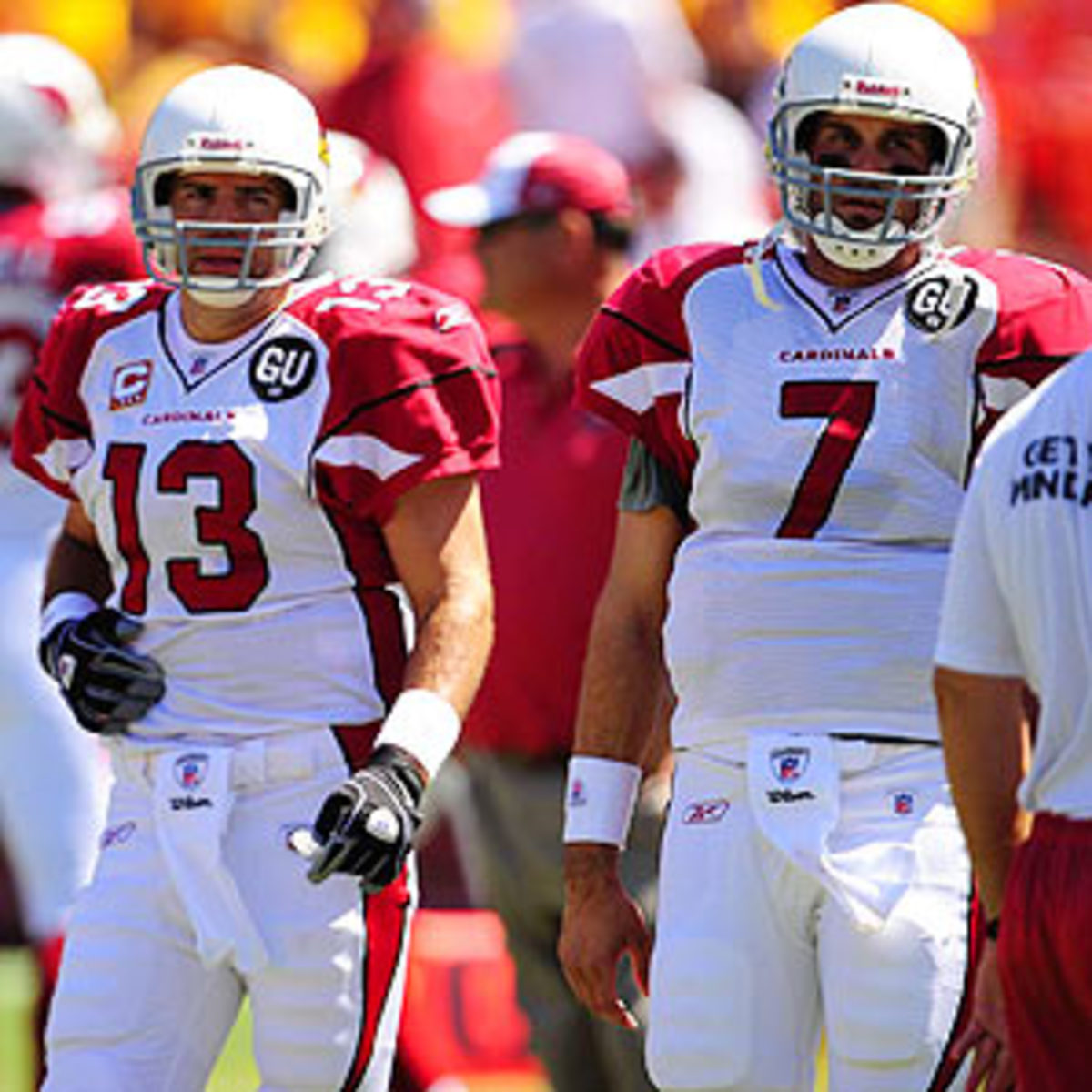Drafting QB of future no guarantee
With Jay Cutler and Kyle Orton having swapped teams, fewer than half of the NFL's 32 franchises (14) now feature starting quarterbacks they selected out of college.
And even that number is a bit less than solid because it presumes Brady Quinn will beat out Derek Anderson as the Browns starter, Tarvaris Jackson holds off Sage Rosenfels in Minnesota, and leaves the Jets' No. 1 job vacant for the time being, on the chance undrafted Brett Ratliff wins his competition against Kellen Clemens (second round, 2006) and Erik Ainge (fifth round, 2008).
Is this an unprecedented development in the NFL? Perhaps not. But for comparison sake, let's look at where the league stood 20 years ago, before full-fledged free agency began and when the draft still went 12 rounds (five more than today). In 1989, 19-of-28 teams (68 percent) featured starting quarterbacks they drafted, with names like Marino, Kelly, Kosar, Esiason, Grogan, Simms, Cunningham, Aikman and Montana heading that list. Heading into the '09 season, that figure is now down to 44 percent (14-of-32) and seems to be falling all the time.
And memo to the Detroit Lions, who are contemplating the selection of a first-round quarterback this year: Proceed at your own considerable risk. First-round QBs have been dropping like flies in the past two years.
We've seen Tennessee bench first-rounder Vince Young in favor of the well-traveled Kerry Collins, Arizona opt for veteran Kurt Warner over first-rounder Matt Leinart, Cutler dealt by Denver and teams like the Jets (Chad Pennington), Bills (J.P. Losman), Bears (Rex Grossman), Jaguars (Leftwich), 49ers (Alex Smith) and Ravens (Kyle Boller) either demoting or releasing their former first-round picks. They've done so usually in favor of quarterbacks taken lower in the draft, sometimes not drafted at all.
We're not quite to the point where being a first-round quarterback is hazardous to one's career, but consider that of the 10 quarterbacks selected in the first round as recently as 2005 or later, only five are the clear-cut starter for the team that drafted them.
And that 50 percent success ratio is a bit deceiving because it's made up of Jason Campbell, who has a tenuous grasp of his job as he enters the final year of his contract in Washington; Aaron Rodgers, who had to sit and wait three years and then endure last year's Brett Favre-inspired drama in Green Bay; JaMarcus Russell, whose start has been painfully slow in Oakland; and last year's twin rookie sensations, Matt Ryan of Atlanta and Joe Flacco of Baltimore. The other less fortunate five are Smith, Leinart, Young, Cutler and Quinn.
For every Donovan McNabb and Ben Roethlisberger long-term success story, there's a Tim Couch, Michael Vick, David Carr or Joey Harrington -- first-round selections whose careers went anything but as expected after going in the top three picks of their draft class. Maybe the Lions should be thinking about that particular trend rather than making signability all-important when it comes to deciding between their top three choices for the vaunted No. 1 spot.
In this decade, it has been just as advantageous -- and maybe more so -- to be a quarterback taken in the lower reaches of the draft. Orton was a fourth-round pick in 2005, but wound up beating out the first-rounder Grossman in Chicago. Anderson was a sixth-round pick of Baltimore's that same season, before going on to Pro Bowl stardom in Cleveland. Matt Cassel went in the seventh round in 2005, Garrard was selected in the fourth round in 2002, Marc Bulger was taken in the sixth round by New Orleans in 2000, a scant 31 slots ahead of the mother of all late-round quarterback picks, sixth-rounder Tom Brady of New England. If you stretch the chains all the way back to the 1998 draft, Matt Hasselbeck, a seventh-round pick of Green Bay's that year, joins that particular parade.
What can we draw from all this? For one, if you need a quarterback of the future in this year's draft, you better not be counting on duplicating the Ryan and Flacco double stroke of lightning from last year. They were aberrations by any recent measurement, and history indicates another pair of first-round ready-made starters aren't likely to be in the pipeline this year for the Detroits and San Franciscos of the league.
Secondly, quarterbacks taken high in the draft have windows of opportunity that seem to grow shorter all the time. We don't know yet if quarterbacks such as Smith, Young, Leinart and Quinn are really going to have starting eras with the teams that drafted them in the top 10, but we do know that in the past three seasons, the door closed on first-rounders in Buffalo, Baltimore, Jacksonville, Denver, Chicago, Detroit, Atlanta and with the Jets. More such scenarios could very well follow this year.
So while we're once again fixated on the top two or three quarterbacks in this year's draft -- debating the relative merits of Matthew Stafford, Mark Sanchez and Josh Freeman -- the fact of the matter is the majority of teams in the NFL haven't had great success of late with the top-rated collegiate passers they've selected. Plenty of teams are now led by someone falling into the category of a highly drafted retread quarterback (Pennington in Miami, Collins in Tennessee, Drew Brees in New Orleans), a late-round pick (Brady, Bulger, Hasselbeck, Cassel) or even a non-drafted passer (a'la Arizona's Warner, Dallas' Tony Romo, Carolina's Jake Delhomme and San Francisco's Shaun Hill).
Taking a quarterback high in the draft has always been the proverbial crapshoot. But as the years go by, choosing a first-day quarterback is becoming the NFL draft's most inexact science.





